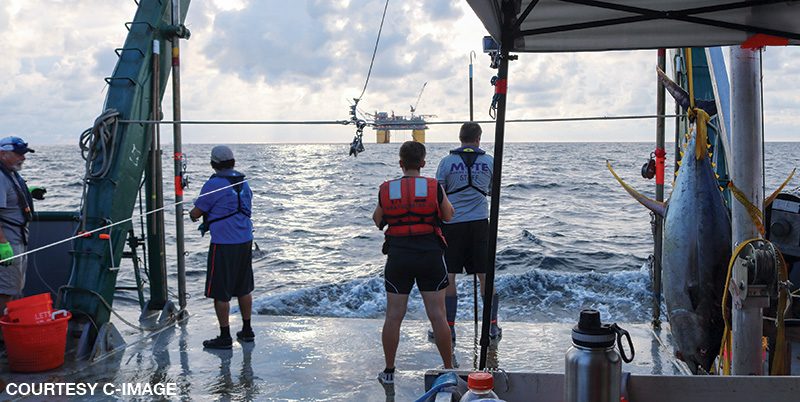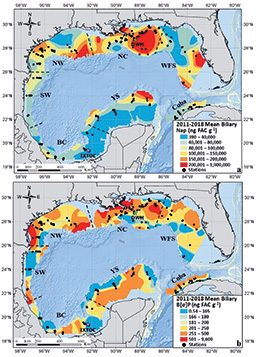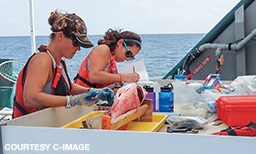Research findings 10 years after the Deepwater Horizon oil spill
The water in the Gulf of Mexico ranges from clear, Caribbean-style blue along the West Florida Shelf to darker tannin-stained hues that characterize the oil-rig-heavy shorelines from Louisiana to Texas. Scientists once described the bottom of the Gulf as a marine desert because of its expansive sandy continental shelf, but over the years sunken ships and oil and gas infrastructures have littered this desert.
Teeming with life, these structures provide essential habitats for corals, sponges and reef fish and are popular with schools of sport fish such as jacks, snappers and groupers, which has helped to elevate the Gulf of Mexico’s reputation as a diver’s paradise. But do divers really know what they are diving into?
Despite the area’s beauty, the majority of the estuaries and coastal environments along the northern Gulf of Mexico coast are highly influenced by human activities that have decreased water quality. Human sources of pollution in the Gulf include excessive amounts of nutrients from lawn fertilizers, chemicals such as pesticides, and oil. Oil in the Gulf can be from several sources including natural seeps, oil and gas extraction, transportation activities, and petroleum consumption (e.g., land-based runoff, marine vessels, etc.).
Pervasive in the western Gulf of Mexico, natural oil seeps have historically accounted for the majority of oil in Gulf waters. Now, however, thousands of small oil spills each year and continuously leaking infrastructure significantly augment the natural levels. In just 87 days the 2010 Deepwater Horizon (DWH) oil spill added to the Gulf about seven times the usual annual amount of oil from all sources. The chronic inputs of oil from all sources combined with those from large spills cause concern for the continuing degradation of environmental conditions and the health of organisms.
The most toxic components of oil are polycyclic aromatic hydrocarbons (PAHs), which can have varying effects on fish, such as changing their dietary habits, altering population size and growth rates, causing skin lesions, increasing disease, and modifying physiological outputs such as swim performance and cardiac function. Fish can efficiently metabolize and purge PAHs from their system to a point, after which the compounds can accumulate in fatty tissues such as the liver, which can lead to disease and toxicity.

To gain a comprehensive understanding of the extent of PAH exposures on fish, our team from the Center for Integrated Modeling and Analysis of Gulf Ecosystems (C-IMAGE) research consortium circumnavigated the Gulf of Mexico to collect thousands of fish for analysis in one of the largest, most comprehensive studies ever conducted in a large marine ecosystem. We sampled a wide variety of fish and categorized them as pelagic species (e.g., tuna, billfish, jacks, dolphinfish), reef fish (e.g., snappers and groupers), coastal species (e.g., red drum, catfish) and offshore benthic species (e.g., hakes, tilefish, eels, dogfish).

After bringing the collected fish to the University of South Florida’s College of Marine Science campus for analysis, we discovered that all of the fish had been exposed to PAHs, and the highest levels of exposure were from fish collected in the north central region of the Gulf near the site of the DWH oil spill and Mississippi River Delta (Figure 1). During the DWH spill, some oil attached itself to particles and sank to the seafloor, so we anticipated finding oil residues in benthic fish that live and feed on the ocean floor. We didn’t expect to discover that the highest exposures measured to date are in yellowfin tuna, a pelagic species, suggesting that oil pollution is chronic and widespread in the Gulf of Mexico.
PAH exposure levels in fishes from the north central region declined the first few years following the DWH oil spill but have significantly increased since then and are still rising. Concurrent studies of tilefish and grouper following DWH showed steep declines in lipid content and condition, which are frequently used as indicators to assess the survival and reproductive success of fish. Researchers also documented changes in diet, high frequencies of skin lesions and population declines in red snapper. Many health effects and changes observed in Gulf fishes are known responses to oil and other pollutants and can significantly affect future population levels.
The north central region of the Gulf is particularly vulnerable to oil and PAH pollution because of the number of active oil rigs, annual spills, leaking wells and riverine input in the area. The region has the majority of the active rigs in the Gulf, located off the coasts of Louisiana, Mississippi and Alabama. Hundreds to thousands of documented oil spills of various magnitudes occur there each year.
Thousands of miles of active and inactive platforms, pipelines and abandoned wells are also in the northern Gulf. These same structures that serve as ideal dive locations and provide essential habitat for marine life are also leaking oil and potentially threatening that same life. Some structures such as pipelines are leaking due to age or as a result of catastrophic accidents. The Taylor Energy Mississippi Canyon (MC20) platform toppled during Hurricane Ivan in 2004, for example, and continues to leak today. Another source of leaking oil is sunken ships, such as the sporadically leaking tanker Joseph M. Cudahy, which was carrying 78,000 barrels of oil when it was torpedoed during World War II off the northwest coast of the Florida Keys and Dry Tortugas.

The oil industry continues to expand into ultra-deep waters of more than 6,500 feet (2,000 meters) and is encroaching on the moratorium region along the West Florida Shelf. As lease blocks expand into these ultra-deep locations, the inherent risk of subsurface blowouts similar to DWH intensify; proportional investments into the adequate technological advances required to prevent and stop a deep blowout have not been made.
The environmental health of the Gulf continues to decline with the continued expansion of oil and gas activities as well as other anthropogenic pollutants. We need to find a balance between satisfying the petroleum industry and protecting environmental health before it’s too late. Otherwise, future generations of divers, snorkelers and beachgoers may not be able to enjoy the Gulf’s underwater treasures.
Reference
Pulster EL, Gracia A, Armenteros M, Toro-Farmer G, Snyder SM, Carr BE, et al. A first comprehensive baseline of hydrocarbon pollution in Gulf of Mexico fishes. Sci Rep 2020; 10:6437. doi: 10.1038/s41598-020-62944-6
Explore More
Watch this video to learn more about research from the University of South Florida regarding the impacts of the Deepwater Horizon oil spill. Read more about their research at https://www.marine.usf.edu/c-image/.
© Alert Diver — Q3/Q4 2020